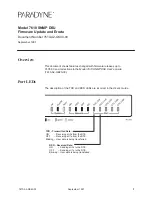
2-4 Riverstone Networks RS 3000 Switch Router Getting Started Guide
Software Overview
Introduction
2.3
SOFTWARE OVERVIEW
This section describes the features and capabilities of the RS 3000 in greater detail. For full information regarding the
use of these features and capabilities, see the
Riverstone RS Switch Router User Guide
.
2.3.1
Bridging
The RS 3000 provides the following types of wire-speed bridging:
Address-based bridging
– The RS 3000 performs this type of bridging by looking up a packet’s destination address
in an L2 lookup table on the line card that received the packet from the network. The L2 lookup table indicates the exit
port(s) for the bridged packet. If the packet is addressed to the RS 3000’s own MAC address, the packet is routed rather
than bridged.
Flow-based bridging
– The RS 3000 performs this type of bridging by looking up a packet’s source and destination
address in an L2 lookup table on the line card that received the packet from the network.
Your choice of bridging method does not affect RS 3000 performance. However, address-based bridging requires
fewer table entries. Alternately, while flow-based bridging uses more table entries, it provides tighter management and
control over bridged traffic, and greater resolution to RMON I statistics.
The RS 3000 ports perform address-based bridging by default, but can be configured to perform flow-based bridging
on a per-port basis. A port cannot be configured to perform both types of bridging at the same time.
2.3.2
Port and Protocol VLANs
The RS 3000 supports the following types of Virtual LANs (VLANs):
Port-based VLANs
– A port-based VLAN is a set of ports that comprises a layer-2 broadcast domain. The RS 3000
confines MAC-layer broadcasts to the ports in the VLAN on which the broadcast originates. RS 3000 ports outside the
VLAN do not receive the broadcast.
Protocol-based VLANs
– A protocol-based VLAN is a named set of ports that comprises an IP, IPX, AppleTalk,
DECNet, SNA, IPv6, or L2 broadcast domain. The RS 3000 confines protocol-specific broadcasts to the ports within
the protocol-based VLAN. Protocol-based VLANs sometimes are called subnet VLANs or layer-3 VLANs.
You can include the same port in more than one VLAN, even in both port-based and protocol-based VLANs.
Moreover, you can define VLANs that span across multiple RS 3000 switches. To simplify VLAN administration, the
RS 3000 supports 802.1Q trunk ports, which allow you to use a single port to “trunk” traffic from multiple VLANs to
another RS 3000 or to a switch that supports 802.1Q.
2.3.3
Routing
The RS 3000 provides wire-speed routing for the following protocols:
IP
– protocol that switching and routing devices use for moving traffic within the Internet and within many corporate
intranets
IPX
– protocol by Novell used in NetWare products
Содержание RS 3000
Страница 1: ...36 004 07 Rev 0A RS 3000 Switch Router Getting Started Guide Release 8 0 ...
Страница 16: ...xvi Riverstone Networks RS 3000 Switch Router Getting Started Guide Figure 3 16 10 100BASE TX RJ 45 port 3 15 ...
Страница 20: ...1 2 Riverstone Networks RS 3000 Switch Router Getting Started Guide Related Documentation About This Guide ...
















































